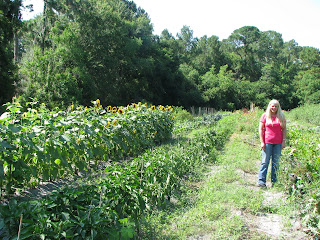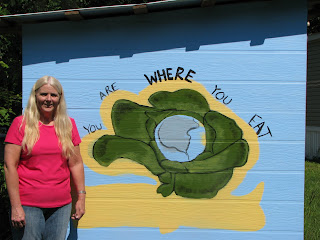One of Jacksonville's many natural assets is one of the largest urban park systems in the country. The active and passive parks and preservation lands are a key part of Jacksonville's quality of life. So are the miles of beaches and waterways, a major symphony orchestra, a sports and entertainment complex downtown and a myriad of special events that this sports-loving city hosts each year. The home of the NFL's Jacksonville Jaguars, the city welcomed its first Super Bowl in 2005. With a growing population, a strong economy, diverse cultural and recreational opportunities and abundant natural resources, Jacksonville continues to distinguish itself as one of the nation's most dynamic and progressive cities. I think that Jacksonville is a beautiful city. Whenever we have out of town guests we always take them on a tour of downtown Jacksonville.
One of my favorite buildings in downtown Jacksonville has a beautiful painting of a Jaguar like it is captured inside the building. Here is a picture:

I work for the law firm of Foley & Lardner in the Modis Building. The Modis Building contains 37 floors, and held the title of tallest building in Florida until 1981, when One Tampa City Center was completed. It remained the tallest building in Jacksonville until 1990, when the Bank of America Tower surpassed it in height. The building was designed by KBJ Architect and it takes up an entire city block in Jacksonville's downtown. A notable feature of the structure is a four story atrium of tropical vegetation where the public enters. The first floor also contained an auditorium with seating for 360 patrons, a bank, restaurants, and several retail stores. The beautiful plants in the atrium are wonderful. At Christmastime it is decorated especially nice!
As a paralegal in Jacksonville, I frequently visit the Duval County courthouse. Here is a picture of me in front of the courthouse:

The Police Memorial Building is right across the street from the courthouse . Here is a picture of me in front of the police station:

Also in downtown Jacksonville is our City Hall. It is across the street from Hemming Park. Every Friday there is a Farmer’s Market in Hemming Park that sells fresh fruit and vegetables. Here is a picture of me in front of City Hall:

Also in downtown Jacksonville there is a Veteran’s Memorial Wall. It is a wall with the names of people from Jacksonville that have died in all of the wars (going back to the civil war through the current war). Here is a picture of the wall: (It is a very moving experience to visit the wall. My husband’s father’s grandfather died in World War II and his name is etched in the wall).

Also downtown and right across the street from the Modis building where I work there is the Jacksonville Landing. It is like a little shopping mall on the water (St. Johns River) downtown. In front of the Landing is a statute of Andrew Jackson. Here is a picture:

And of course, we can't forget that Jacksonville is home to the NFL football team - the Jaguars. Here is a picture of me in front of the football stadium standing by the statute of the jaguar:

Also downtown is the Museum of Science and History (called the MOSH). Here is a picture of the MOSH:

My husband and I visited the MOSH on Friday, June 25, 2010. The cost to enter was $9.50 each. They gave us the “senior” rate – 55 yrs or older). This is primarily a children’s museum. I have been to the MOSH many times. I often take the grandchildren there to see the various exhibits. Also – when my youngest son got married we had the wedding rehearsal dinner on the second floor of the MOSH with the animatronic dinosaur exhibit. It was really cool – they put the tables amongst the moving dinosaurs. Also they have a planetarium and you can see laser light shows and cosmic concerts. I have been to them on several occasions.
Here is a picture of me at the MOSH parking sign:

The MOSH does have a great Florida history exhibit. It has many displays about the Indians and the history of Florida. Here are some photos of me at the history exhibit:




The MOSH has many murals on the wall of pictures of the way the City of Jacksonville looked many years ago:


They also have a conservation exhibit and naturalist exhibit – which includes reptiles and whales. Here is a picture from the whales exhibit:

I always like visiting downtown Jacksonville. It is a thriving and active place. It has many new buildings and also many historical buildings. I always enjoy visiting the MOSH – it has exciting and relevant exhibits. Downtown Jacksonville has many one way streets and this confuses many first time visitors. The things that impact me the most about Jacksonville are: the veteran’s memorial wall – I love it when our veterans are appreciated and honored; - also the St. Johns River runs through the middle of downtown Jacksonville. It is a beautiful natural resource.
The city has been trying for years to redesign the urban area to encourage more community involvement – but it really is just not working. Most people work downtown and then they want to go home when they get off of work – they do not want to “hang around” downtown after work. Many people have children or pets at home and cannot just stay downtown after work. Jacksonville has a serious homeless people problem and there are a lot of homeless people that are downtown at the bus station and in the parks.
I really do not have any idea how to redesign the urban area to encourage more community engagement – because Jacksonville is already doing a very good job of that. They have Farmer’s Markets on Fridays in the downtown area and they also have Art Walks on Wednesdays during the summer. They have built condos downtown. They have the Jazz Festival and other festivals downtown on a regular basis.
The thing that impacts me the most about Jacksonville is how very beautiful it is. The river runs through the middle of the city. The downtown buildings are a mixture of modern architect and old architect. The churches downtown really stand out and are gorgeous. We have a beautiful new arena, a beautiful new baseball stadium and a state of the art football stadium. They have a huge municipal park downtown on the water where outside concerts are held. I am glad that I live in a city like Jacksonville.
(NOTE: All photos were taken by me and my husband (Steve) with our camera)






